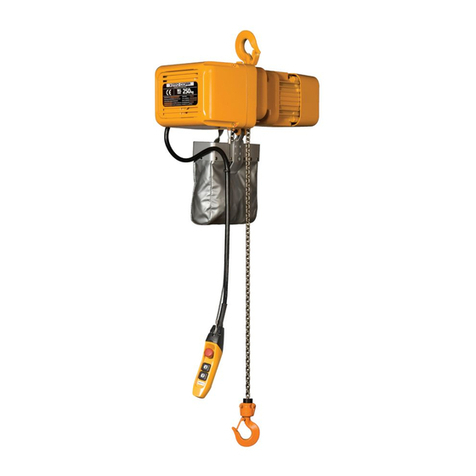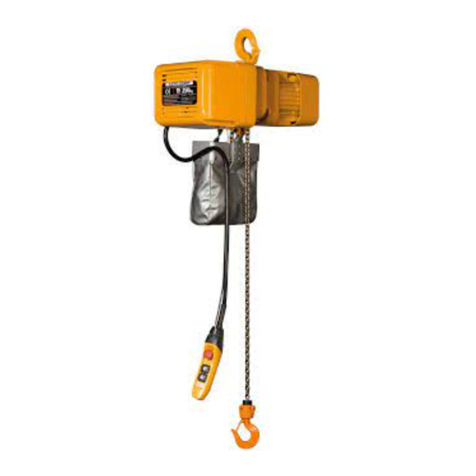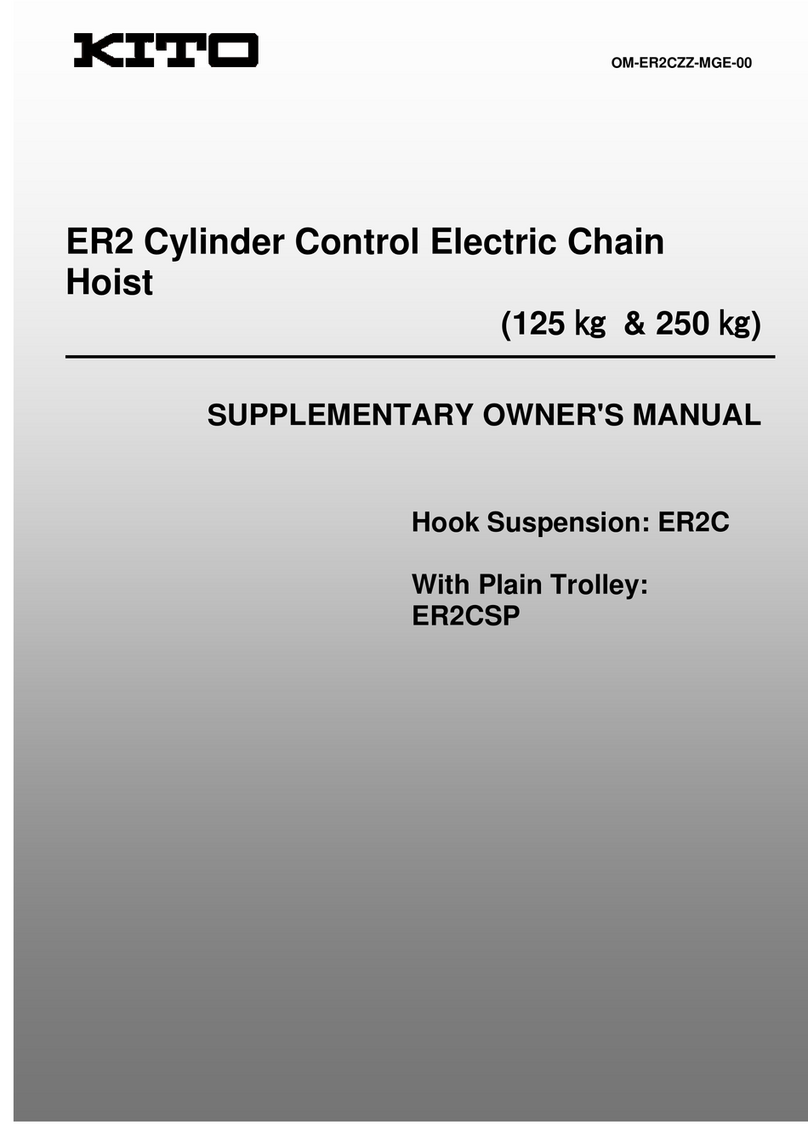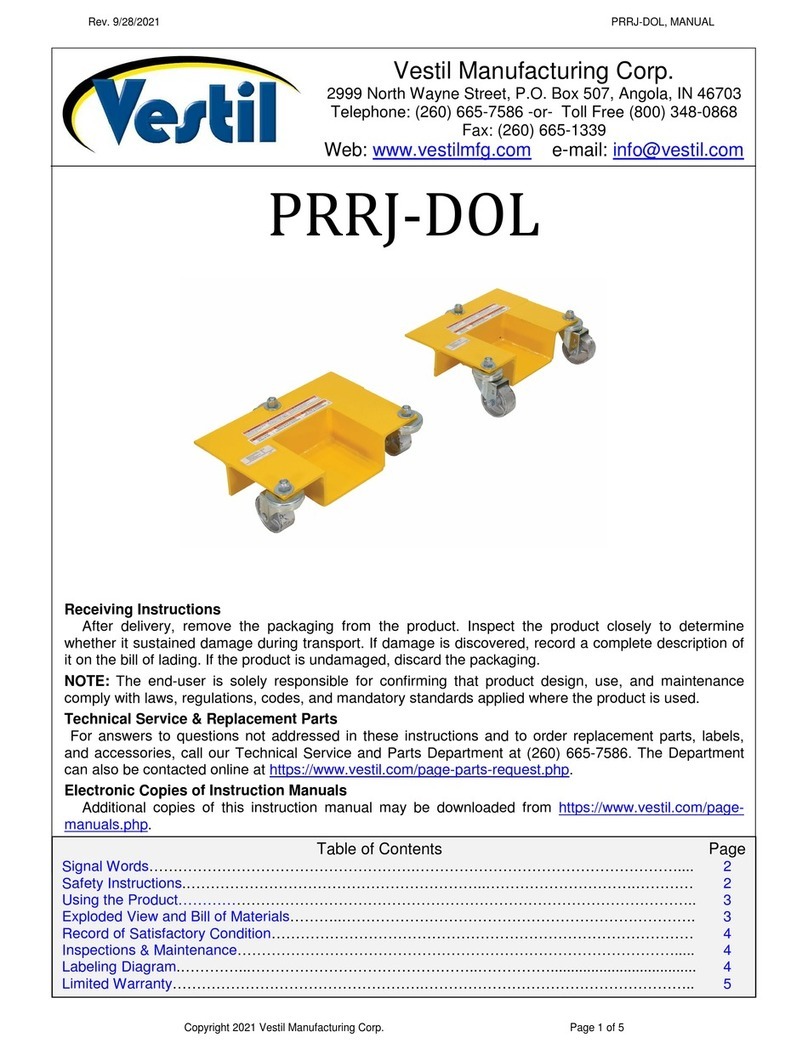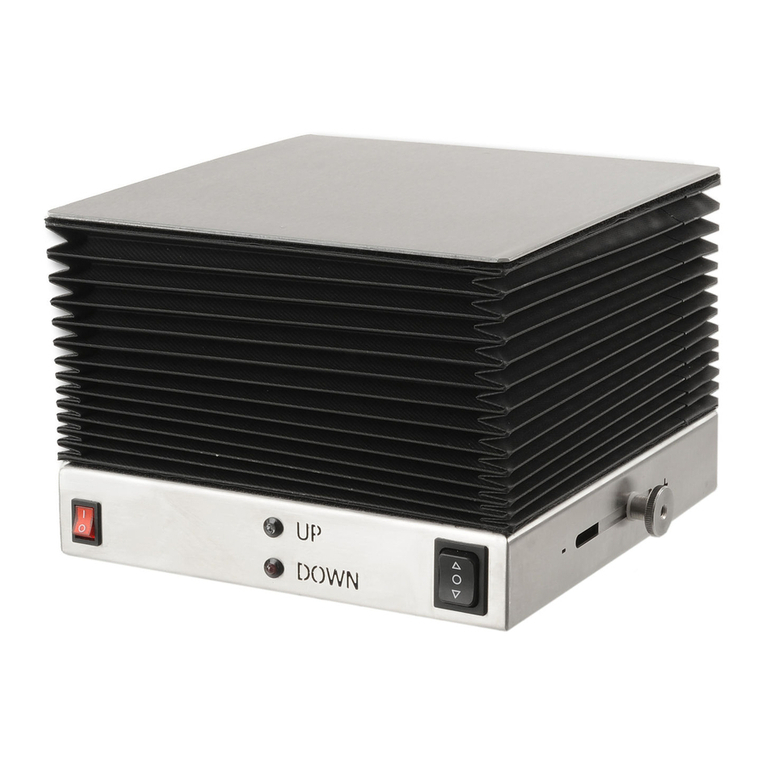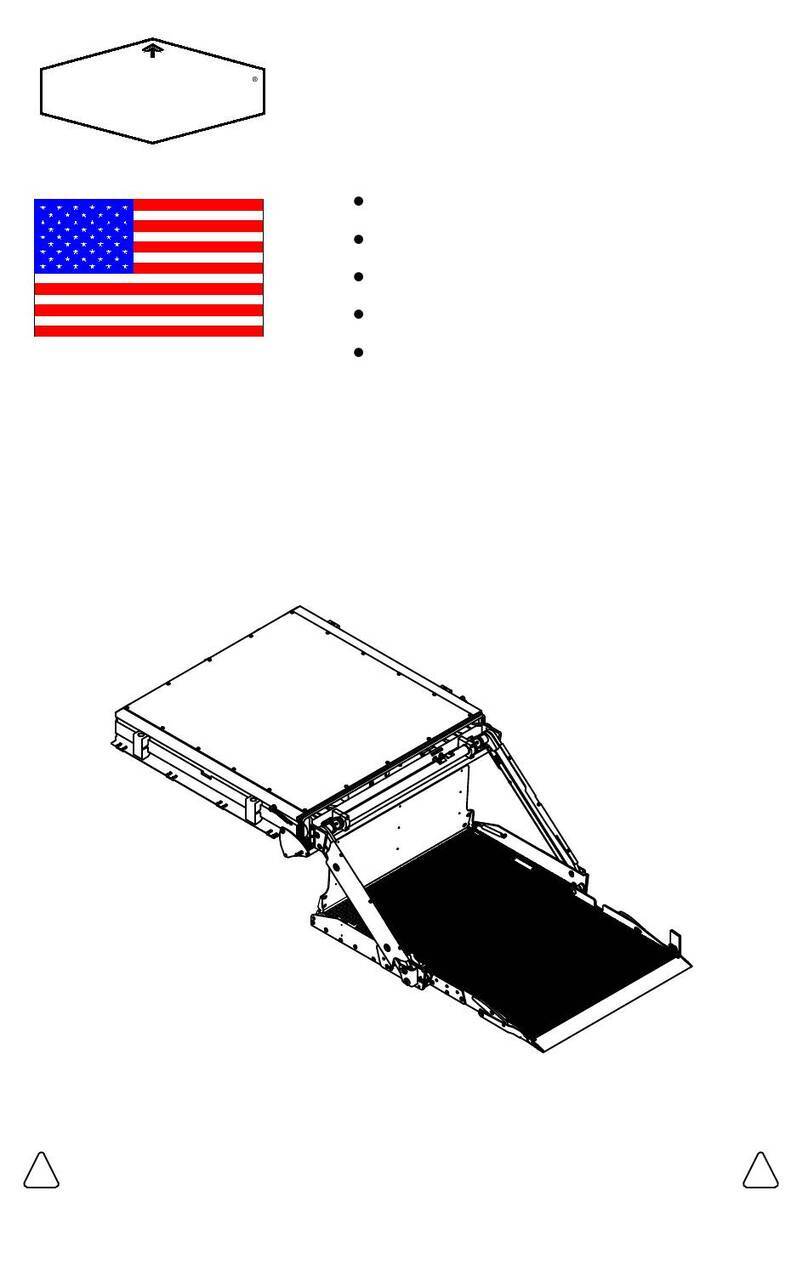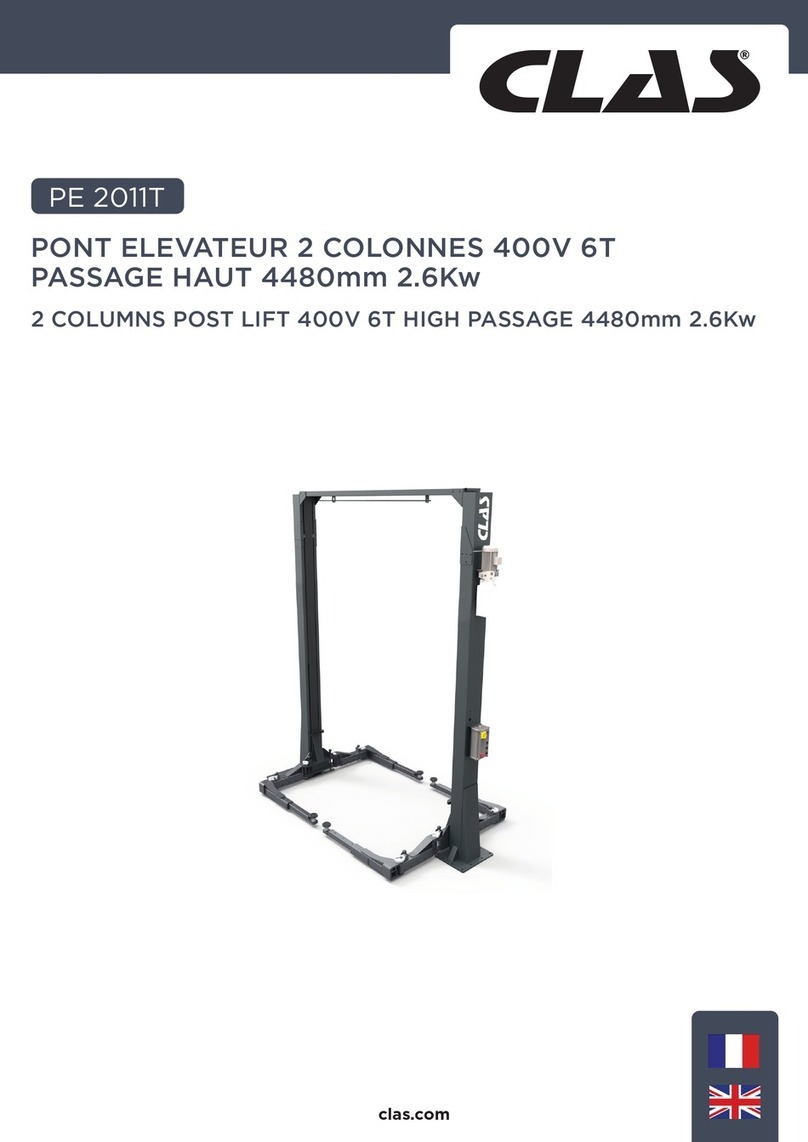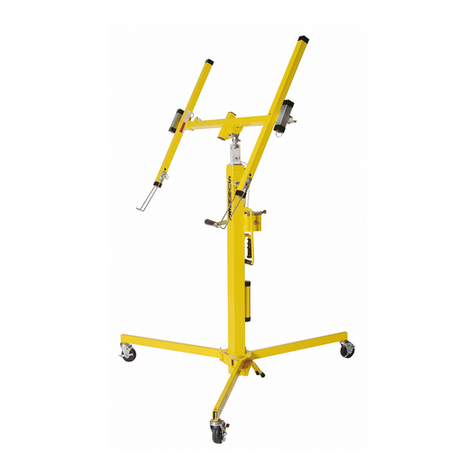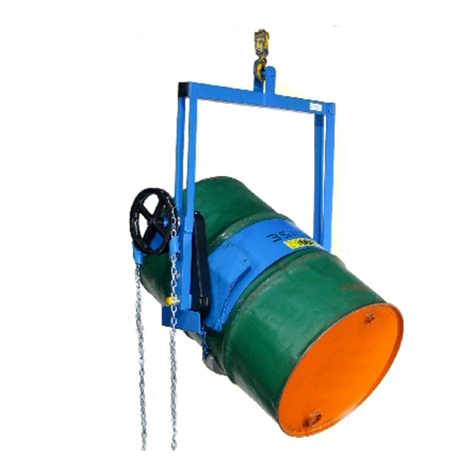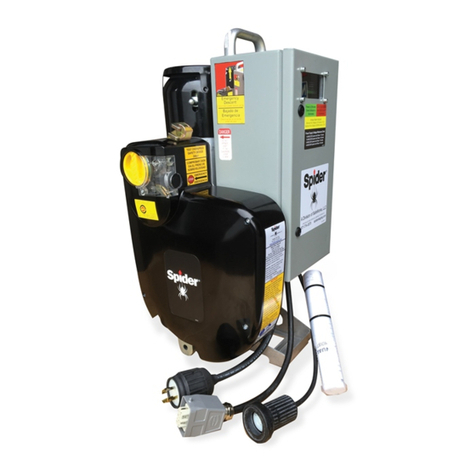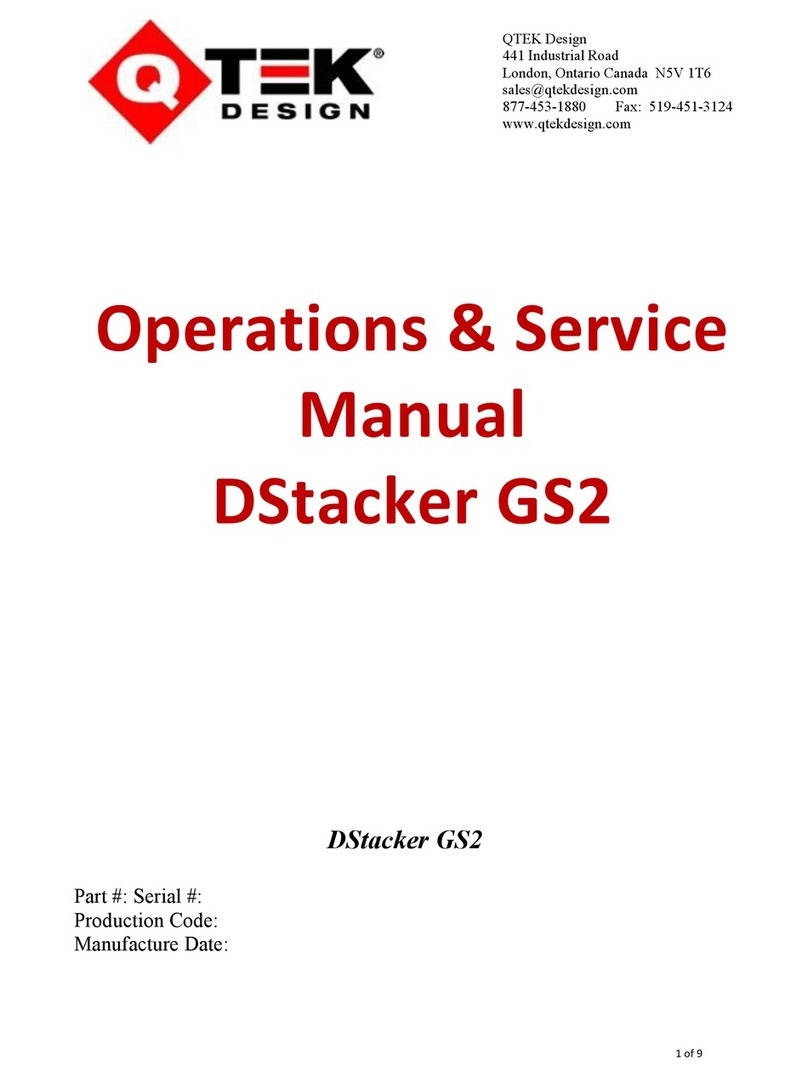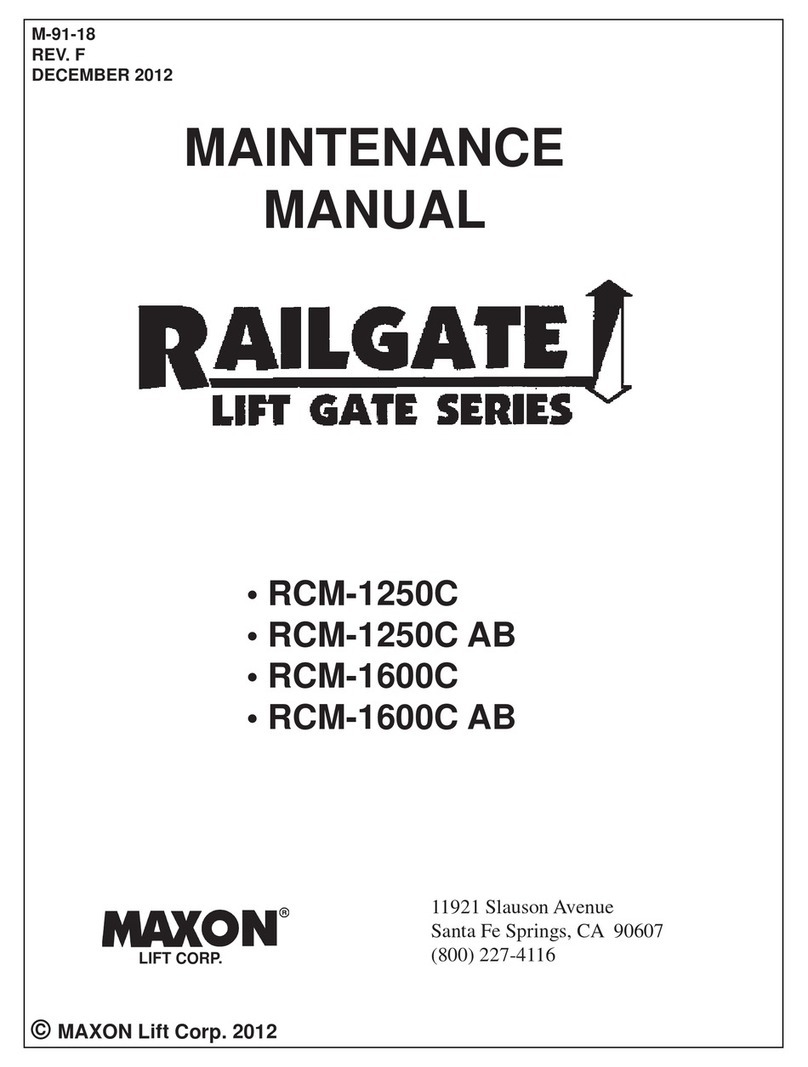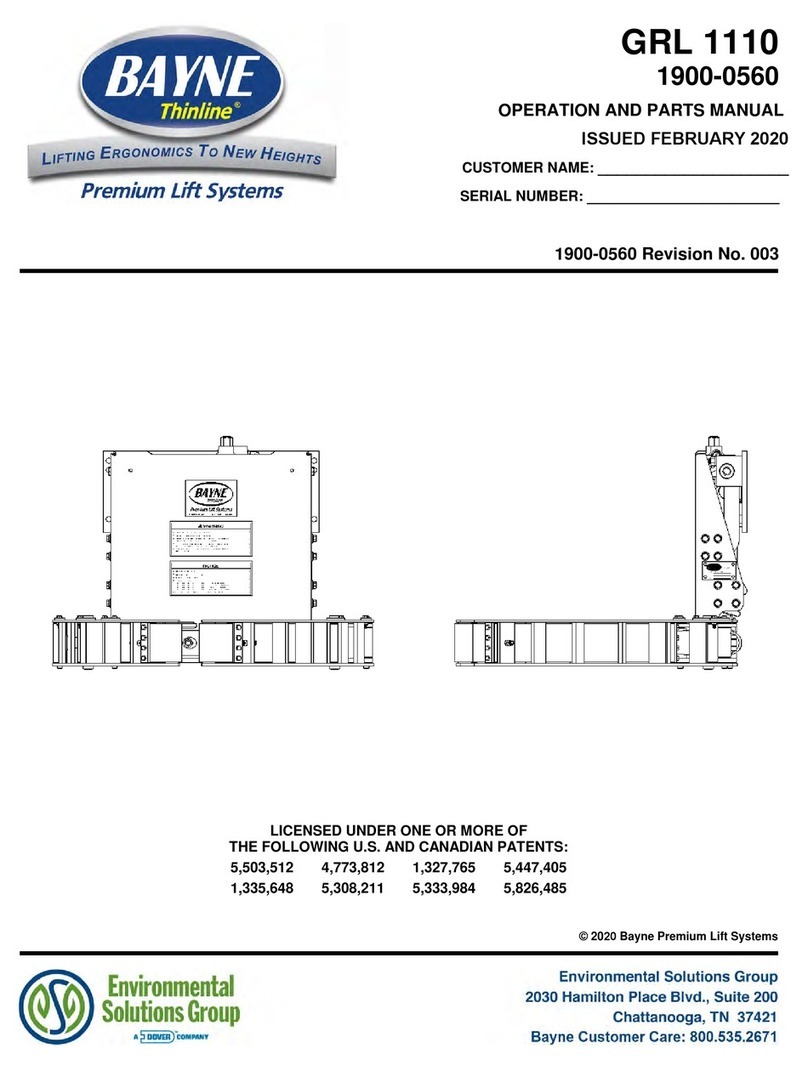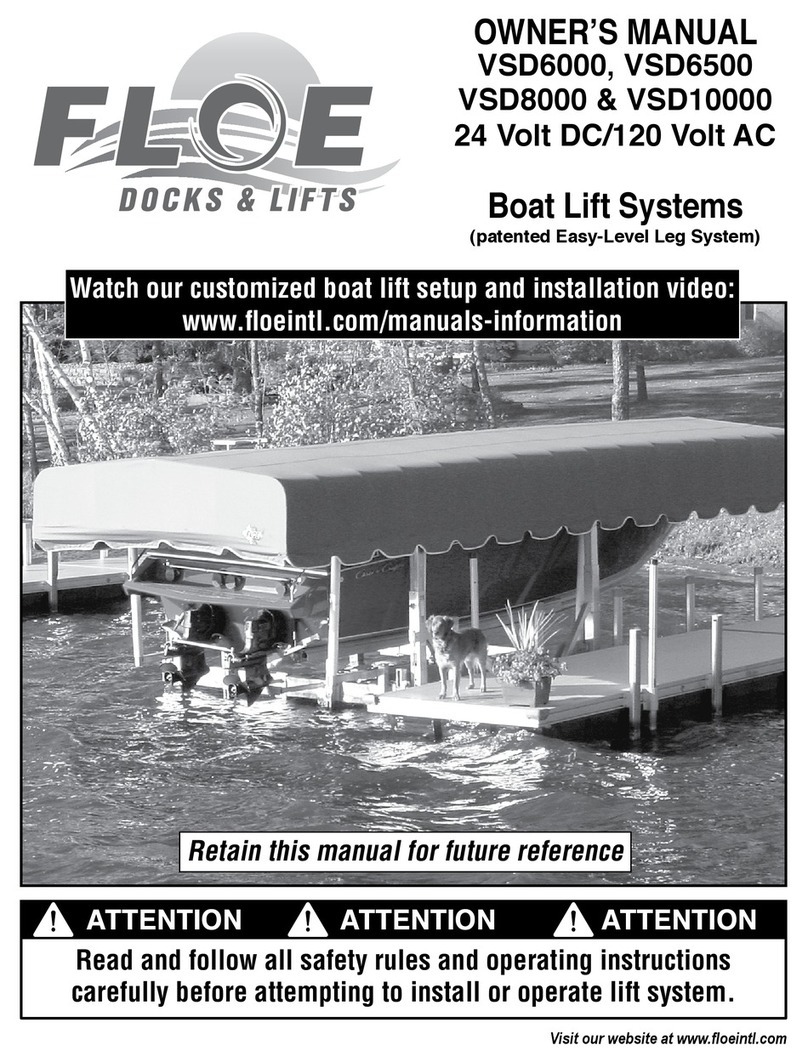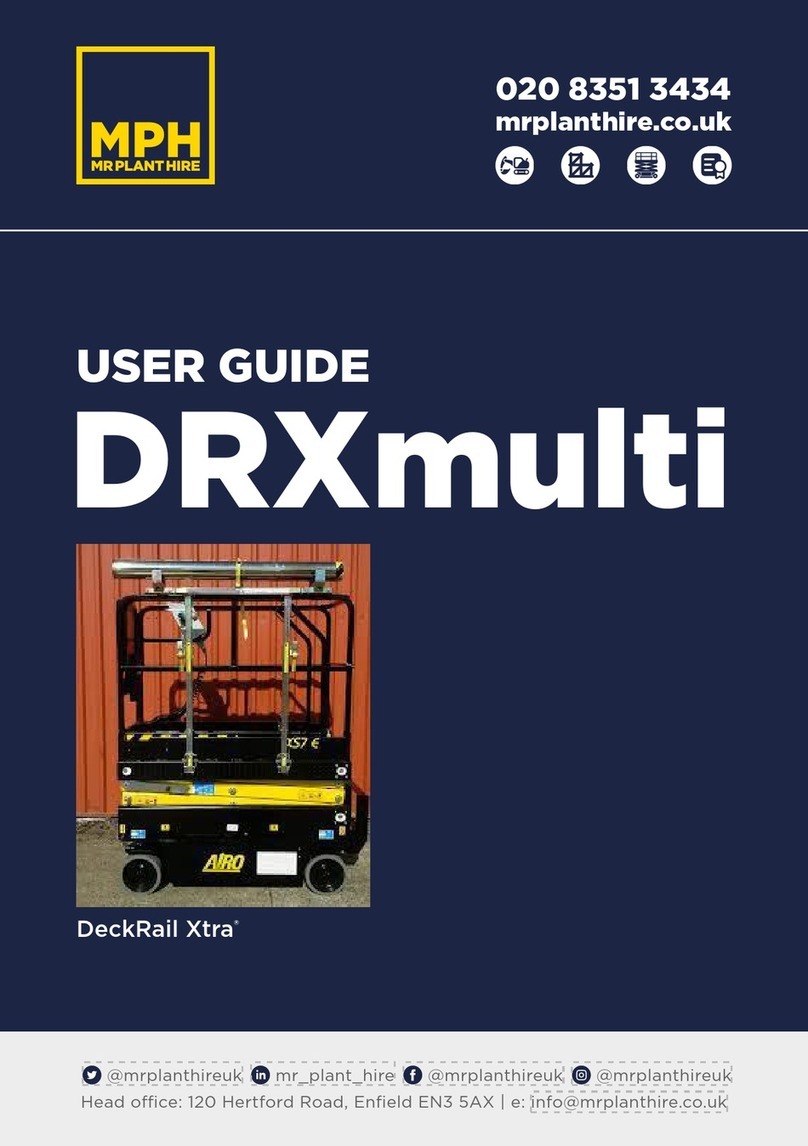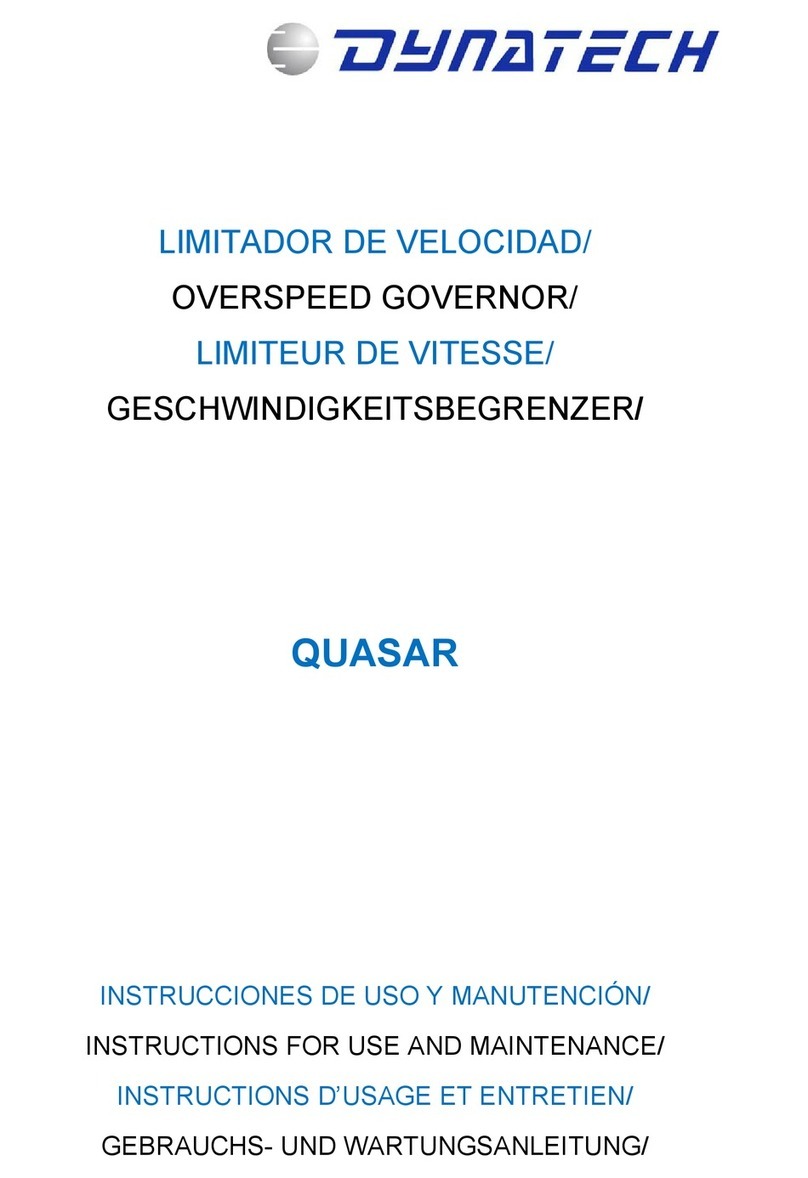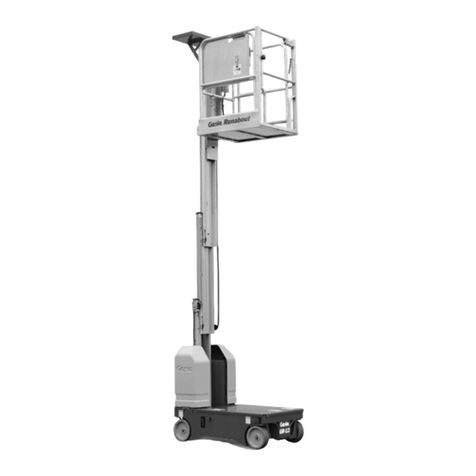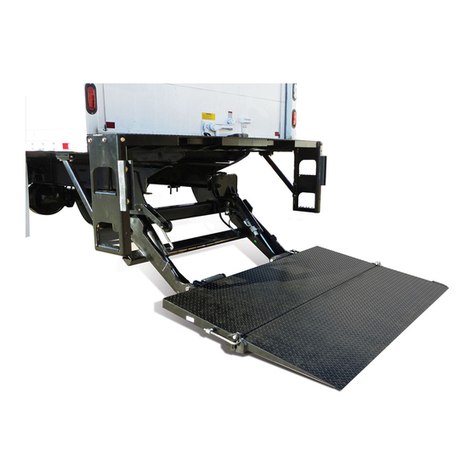KITO TS Series Operation instructions

OM-TSZZZZ-CEE-01
OWNER’S (OPERATOR’S) MANUAL
AND SAFETY INSTRUCTIONS
FOR KITO PLAIN AND GEARED TROLLEY
TSSERIES
ALWAYS SAVE THIS BOOK FOR FUTURE REFERENCE.
Original Instruction
Issued September 1994. Revised July, 2016 (revision 11)
This instructions describe for connection with manual hoists. In case of connection with electric chain
hoist ER2 series, please refer to the “ER2 electric chain hoist Owner’s Manual”.

CONTENTS
1. DEFINITIONS........................................................................................................................................... 1
2. INTENDED PURPOSE............................................................................................................................. 1
3. BEFORE USE ........................................................................................................................................... 1
3.1 Safety summary ...................................................................................................................................... 1
3.2 Safety instructions................................................................................................................................... 2
4. MAIN SPECIFICATIONS........................................................................................................................ 4
5. INSTALLATION ...................................................................................................................................... 6
5.1 Coupling with manual chain hoists......................................................................................................... 6
5.2 Coupling with electric chain hoists......................................................................................................... 7
5.3 Adjusting trolley width before installation ........................................................................................... 10
5.4 Installation of trolley onto beam........................................................................................................... 10
5.5 Installation of stopper onto traversing beam......................................................................................... 11
5.6 Check points after installation .............................................................................................................. 11
6. OPERATION........................................................................................................................................... 11
6.1 Intended purpose of trolley operation................................................................................................... 11
6.2 Safety working environment................................................................................................................. 11
6.3 Operation .............................................................................................................................................. 11
6.4 Trolley storage...................................................................................................................................... 12
7. INSPECTION.......................................................................................................................................... 12
7.1 Outline .................................................................................................................................................. 12
7.2 Daily inspection.................................................................................................................................... 12
7.3 Periodic inspection................................................................................................................................ 13
8. MAINTENANCE.................................................................................................................................... 16
8.1 Lubrication............................................................................................................................................ 16
8.2 Overhaul and assembly......................................................................................................................... 16
9. BUFFER.................................................................................................................................................. 18
9.1 Buffer.................................................................................................................................................... 18
10. WARRANTY.......................................................................................................................................... 19
11. PARTS LIST ........................................................................................................................................... 20
12. CONTENTS OF EC DECLARATION OF CONFORMITY.................................................................. 25

- 1 -
1. DEFINITIONS
: Indicates a potentially hazardous situation which, if not avoided, could result
in death or serious injury.
: Indicates a potentially hazardous situation which, if not avoided, may result in
minor or moderate injury. It may also be used to alert against unsafe
practices.
WLL: Indicates maximum mass (working load limit) which a trolley is designed to support in
general service.
2. INTENDED PURPOSE
This trolley is designed for horizontally transporting loads by hand, through manual or electric hoist under
normal atomospheric conditions of the work place.
3. BEFORE USE
3.1 Safety summary
Danger exists when heavy loads are transported, particularly when the equipment is
not being used properly or is poorly maintained. Becuase accidents and serious injury
could result, special safety precautions apply to the operation, maintenance and
inspection of the KITO plain and geared trolley TS series.
The safety factor of the tolloey is 4:1. The hoist may lift and hold a load more than the
rated loads check that structure for mounting the tolley has sufficient strength.
NEVER use a trolly for transporting people.
NEVER transport loads over or near people.
NEVER transport more than WLL which is shown on the name plate.
ALWAYS let people around you know when a transport is about to begin.
ALWAYS read the operation and safety instructions.
Remember proper handling techniques are the responsibility of the operator. Check all
applicable safety codes, regulations and other applicable laws for further information about
the safe use of your trolley.
More detailed safety information is contained in the following pages. For
additional information, please contact KITO Corporation or your authorized KITO
dealer.
WARNING
CAUTION
WARNING

- 2 -
3.2 Safety instructions
If this trolley is used in conjunction with a hoist, also refer to the hoist manual for additional precautions and
instructions.
3.2.1 Before use
ALWAYS be sure to wear the proper clothing and personal protective equipment when
using and operating the product.
ALWAYS allow the instructed (trained in safety and operation) person to operate the
trolley.
ALWAYS lubricate the trolley regularly (Refer to 8.1).
ALWAYS rig the load properly and carefully.
ALWAYS check the trolley according to the “Daily inspection” (Refer to 7.2)
NEVER use a trolley if the flange width does not fit to the rail.
NEVER connect the hoist to the trolley with improper fittings.
NEVER use a trolley withot a name plate.
3.2.2 While operation
ALWAYS make sure that the load does not get in a way of hand chain.
ALWAYS when any abnormality is observed during the operation, stop the operation
immediately, indicate “FAILURE” and contact with the maintenance engineers.
ALWAYS when inspecting and repairing, be sure to indicate “INSPECTION” and carry out
without lifting a load.
NEVER strike a trolley intentionally to the stopper.
NEVER swing a suspended load.
NEVER weld or cut a load suspended by the trolley.
NEVER allow a trolley to collide with another trolley.
NEVER operate a trolley unless load is centered under the trolley.
3.2.3 After operation
NEVER leave a suspended load unattended.
NEVER throw a trolley.
3.2.4 Maintenance
ALWAYS let the qualified service personnel inspect the trolley periodically (Refer to 7.3).
WARNING

- 3 -
3.2.5 Others
ALWAYS consult the manufacturer or your dealers if you plan to use a trolley in an
excessively corrosive environment. (Salt water, sea air and/or acid, explosive
environment or other corrosive compounds, etc.).
ALWAYS when not in use of the trolley store it at dry place where appropriate for the
weight and size.
ALWAYS use a trolley within rail slope of 1 degree.
ALWAYS when transferring including handling, and storing the product, carry it out
carefully making sure of the product’s weight and size.
NEVER use a trolley which has been taken out of service until the trolley has been
properly repaired or replaced.
NEVER remove or obscure the warning stickers.

- 4 -
4. MAIN SPECIFICATIONS
0.5 to 3 t
5 t
For manual chain hoist For electric chain hoist
Rail tread Rail tread
Suspender C
Suspender C
(3t, 5t)
Suspender E,G
Rail tread

- 5 -
Code/C (1) or. E (2)
WLL
(t)
Rail width adjustability (mm) Min
radius
for
curve
(mm)
Net
Weight
(kg)
Hand chain
folded
length (m)
a
[Max.]
(mm)
Plain
trolley Geared
trolley Standard Option
W30 TSP TSG C(1) E(2) C(1) E(2)
TSP005C (E) TSG005C (E) 0.5 50 to 163 164 to 305 1100(3) 4.5 ― ― ― 173 173
TSP010C (E) TSG010C (E) 1 58 to 163 164 to 305 1300(3) 8 12 2.5 3 275 (215) 311
(215)
TSP015C TSG015C 1.5 82 to 163 164 to 305 1500 14 18 2.5 2.5 349 (264) ―
TSP020C (E) TSG020C (E) 2 82 to 204 205 to 305 1500 14 19 3 3 349 (264) 349 (264)
TSP025C (E) TSG025C (E) 2.5 82 to 204 205 to 305 1700 23 27 3 3 359 (280) 359 (280)
TSP030C (E) TSG030C (E) 3 82 to 204 205 to 305 1700 23 27 3 3 359 (280) 359 (280)
TSP050C (E) TSG050C (E) 5 100 to 204 205 to 305 2300 50 56 3.5 3.5 376
(273) 376
(273)
Code/C (1) or E (2)
WLL
(t)
b (mm) d
(mm)
e (mm) f (m) g
(mm) h
(mm) k
(mm)
ℓ (mm) m
(mm) n
(mm) p
(mm) q
(mm)
Plain
trolley Geared
trolley C(1) E(2) C(1) E(2) C(1) E(2) C(1) E(2) C(1) C(1) C(1) C(1)
TSP005C (E) TSG005C (E) 0.5 204 204 182 46 46 2.7 2.7 76 84 22 93 98 26 33 14 14
TSP010C (E) TSG010C (E) 1 309
(249) 345
(249) 236 116
(56) 152
(56) 2.2 2.7 95 112 25 106 — 28 37 18 18
TSP015C TSG015C 1.5 385
(300) ―280 154
(69) — 2.2 — 112 131 32 129 119 32 40 22 22
TSP020C (E) TSG 020C (E) 2 385
(300) 385
(300) 280 154
(69) 154
(69) 2.7 2.7 112 131 32 129 138 32 40 22 22
TSP025C (E) TSG025C (E) 2.5 398
(320) 398
(320) 324 157
(79) 157
(79) 2.7 2.7 134 152 36 144 153 36 44 27 25
TSP030C (E) TSG030C (E) 3 398
(320) 398
(320) 324 157
(79) 157
(79) 2.7 2.7 134 152 36 169 153 40 48 24 30
TSP050C (E) TSG050C (E) 5 401
(297) 401
(297) 400 156
(53) 156
(53) 3.2 3.2 144 178 54 228 171 60 70 33 36
Note: (1) C: For manual chain hoist.
(2) E: For electric chain hoist.
(3) Minimum flange width for curved rail;
(a) 0.5t trolley....................................57 mm
(b) 1t trolly........................................73 mm
(c) 2.5t and 3t trolley.........................89 mm
Remark : 1) Figures in parentheses show the data for plain trolley type.
2) The maximum 300mm rail width are available as option.
3) Net weight is when flange width is in standard range.
4) Dimension “a” is when flange width is adjusted to the maximum of the standard range.
5) Dimension “b” is when flange width is in standard range.
Allowable ambient conditions;
Operation temperature: -40C to +60C: (–20°C to + 40°C for the use with a electric chain hoist)
Operation humidity: 100%
Note:
- Install the trolley at the level where an operator is able to operate the hand chain from the ground level.
- If the adjustment of the bottom of the hand chain between 500 mm and 1000 mm from the ground is
required, consult KITO.
This device was tested according to the required static and dynamic load test provided on the European
standard EN 13157.

- 6 -
5. INSTALLATION
5.1 Coupling with manual chain hoists
(1) The M3 series hoist can be coupled either in
the hook suspension method (the top hook is
hung from the suspender C as shown in Fig.
5-1), or in the direct coupling method (the hoist
body, with the top hook removed, is directly
coupled to the suspender C as shown in
Fig.5-2).
However the 7.5t and larger capacity M3 series
hoist can only be suspended by the hook
suspension method and the top hook must be
hung from the suspension shaft of the trolley.
The CF series hoist can be suspended with suspender C like Fig.5-3.
(2) The hook suspension method type is best for circumstances when the chain hoist is transferred
frequently.
The direct coupling method is best for circumstances which require as much effective hoisting length as
possible, especially where the height of ceiling is low.
(3) Direct coupling method of M3 series chain hoist.
(a) For 0.5 to 2.5t (Refer to Fig.5-4)
1) Remove the wheel cover nuts and the
spring washers, then remove the wheel
cover.
2) Remove the split pin from the top pin,
then remove the top pin and the top
hook.
3) Mount the suspender C to the hoist
body with the top pin which has been
removed as above. Then insert a new
split pin.
4) Securely bend the split pin as shown in
Fig.5-5
5) Install the wheel cover, as it was before,
with the nuts and the spring washers.
Fig. 5
-
1
TSP+M3CB
Nut
Fig. 5-4 Mounting suspender C
Top hook
Top pin
Split
pin
Fig. 5-5 Split pin bending
Suspender C
Spring washer
Wheel cover
(0.5t to 2.5t)
Split pin
Top pin
Fig. 5
-
2
TSG+M3CB
Fig. 5
-
3
TSP+CF
Nut

- 7 -
(b) For 3 or 5t (Refer to Fig.5-6)
In addition to the procedure stated earlier,
the following steps are also required.
1) Remove the split pin (from the slotted
nut), and then remove the slotted nut,
the chain pin and the load chain from
the top hook.
2) Connect the end of the load chain and
the suspender C with the chain pin, the
slotted nut and a new split pin.
3) Bend securely the split pin.
4) Make sure that no twisting and no
capsizing of the load chain occurs.
5.2 Coupling with electric chain hoists
5.2.1 ES, EF series
The direct coupling method shown in Fig.5-9 should be applied.
(1) Remove the split pin, the slotted nut and the top pin (in the case of double falls of the chain, the top
bolt), and then remove the top hook. (Refer to Fig.5-7).
(2) Mount the suspender E to the hoist body with the top pin (or the top bolt) and the slotted nut which
have been removed as above. Then insert a new split pin and bend it securely as shown in Fig.5-5 on
page 6.
(3) The EF series electric chain hoist can be suspended by the suspender E like Fig.5-10.
F
ig. 5
-
6
Mounting suspender C
Top hook
Top pin
Suspender C
Wheel cover
Spring washer
Nut
Chain pin
Slotted nut
Split pin
(3t to 5t)
F
ig. 5
-
7
Mounting suspender
E
Fig. 5
-
8 Suspender
for double chain
falls hoist
F
ig. 5
-
9
TSG+ES
F
ig. 5
-
10
TSP+EF
Top hook
Top pin
Split pin
Suspender E
Slotted nut
Suspender E for
double falls of chain
Split
pin

- 8 -
Table 5.1 Adjusting spacers arrangement on suspension shaft
Capacity (t) Parts
Name
Beam flange width (mm)
Plain
trolley
Geared
trolley 50 58 66 74 82 90 91 98 106 113 119 125 131 137 143 144
125kg
250kg
500kg
Thin
spacer Inner23441123341111223445122334011212
Outer 7 4 10 7 5 10 10 8 5 3 9 7 5 11 9 9
Thick
spacer Inner00001111112222222222333333444444
Outer8866644444222000
Fixing
spacer Inner00000000000000000000000000000000
Outer0000000000000000
1t
125kg
250kg
500kg
1t
Thin
spacer Inner 3 4 0 1 2 2 3 3 0 1 0 1 1 2 3 3 4 4 1 1 2 2 3 3 0 0 1 1 1 1
Outer 4 10 7 5 10 10 8 5 3 9 7 5 11 9 9
Thick
spacer Inner 0 0 1 1 1 1 1 1 2 2 2 2 2 2 2 2 2 2 3 3 3 3 3 3 4 4 4 4 4 4
Outer 866644444222000
Fixing
spacer Inner 0 0 0 0 0 0 0 0 0 0 0 0 0 0 0 0 0 0 0 0 0 0 0 0 0 0 0 0 0 0
Outer 000000000000000
1.6t
2t
Thin
spacer Inner 2 3 0 0 0 0 1 2 2 3 3 4 0 1 1 2 2 3 3 4 0 1 0 1
Outer 277420642066
Thick
spacer Inner 0 0 1 1 1 1 1 1 1 1 1 1 2 2 2 2 2 2 2 2 3 3 3 3
Outer 10 8 8 8 8 8 6 6 6 6 4 4
Fixing
spacer Inner 0 0 0 0 0 0 0 0 0 0 0 0 0 0 0 0 0 0 0 0 0 0 0 0
Outer 000000000000
2.5t
3.2t
Thin
spacer Inner 2 3 3 4 3 4 1 1 2 2 3 3 4 4 1 1 2 2 3 3 4 4 0 1
Outer 9 7 7 12 10 8 6 12 10 8 6 13
Thick
spacer Inner 2 2 2 2 2 2 3 3 3 3 3 3 3 3 4 4 4 4 4 4 4 4 5 5
Outer 888666644442
Fixing
spacer Inner 0 0 0 0 0 0 0 0 0 0 0 0 0 0 0 0 0 0 0 0 0 0 0 0
Outer 000000000000
5t
Thin
spacer Inner 1 1 2 3 3 3 0 0 1 1 2 2 3 3 3 3
Outer 10 7 6 12 10 8 6 6
Thick
spacer Inner 0 0 0 0 0 0 1 1 1 1 1 1 1 1 1 1
Outer 6 6 6 4 4 4 4 4
Fixing
spacer Inner 0 0 0 0 0 0 0 0 0 0 0 0 0 0 0 0
Outer 0 0 0 0 0 0 0 0
NOTE: 1) Adjustment of trolley width.
Refer to 5.3 on page 10.
Adjust the dimensions by appropriately increasing or decreasing the number of inner or outer adjusting
spacers, without strictly adhering to the number of adjusting spacers shown in the above table.
2) Thick Spacer and Thin Spacer are silver and Fixing Spacer is black.

- 9 -
Capacity (t) Parts
Name
Beam flange width (mm)
Plain
trolley
Geared
trolley 149 155 163 170 178 185 200 201 204 210 220 240 260 280 300 305
125kg
250kg
500kg
Thin
spacer Inner23344500112201111222443322124525
Outer7539758765135602
Thick
spacer Inner44444433333344444444445566777787
Outer0009997777753110
Fixing
spacer Inner00000011111111111111111111111111
Outer0000000000000000
1t
125kg
250kg
500kg
1t
Thin
spacer Inner22334400112201111222443322124525
Outer7539758765135602
Thick
spacer Inner44444422222233333333334455666676
Outer0009997777753110
Fixing
spacer Inner00000011111111111111111111111111
Outer0000000000000000
1.6t
2t
Thin
spacer Inner12233411223312222222443322124525
Outer4205314335135602
Thick
spacer Inner33333344444455555522223344555565
Outer4442220007753110
Fixing
spacer Inner00000000000000000011111111111111
Outer0000000000000000
2.5t
3.2t
Thin
spacer Inner11223301123355565622443322124525
Outer 12 10 8 13 11 8 4 3 3 5 1 3 5 6 0 2
Thick
spacer Inner55555566666666666622223344555565
Outer2220000007753110
Fixing
spacer Inner00000000000000000011111111111111
Outer0000000000000000
5t
Thin
spacer Inner00112334012244455512342312114415
Outer 12 10 7 5 11 8 4 3 2 5 1 3 5 8 0 2
Thick
spacer Inner22222222333333333311112233444454
Outer2222000007753110
Fixing
spacer Inner00000000000000000011111111111111
Outer0000000000000000
NOTE:3) Take note the numbers on spacers of inner side as follows.
Example of 0 + 1 0 + 1
Standard W30
Number on side plate G or S
Number on side plate SN
Side plate SN (Up-to 3t) Side plate G or S
Thick spacer
Thin spacer
Fixing
spcer
Thin spacer
Thick spacer

- 10 -
5.2.2 ER Series
The direct coupling method shown Fig. 5-14 should be applied.
Mount the suspender G to the connection yoke with the connection yoke rubber, the yoke bolt and the
slotted nut. (Refer to Fig. 5-13) Then insert a split pin and bend it securely as shown in Fig. 5-5.
Please refer to an ER2 series owner’s manual for coupling with the ER2 series.
5.3 Adjusting trolley width before installation
When the trolley and the chain hoist are coupled, the trolley
must be adjusted with the adjusting spacers (Refer to Table
5-1).
(1) Make sure that the direction is as shown in Fig. 5-1, 5-2,
5-3, 5-9 or 5-10
(2) The right and left side plates should be as far apart as
possible, and difference between A and B should be
approximately 4mm (Refer to Fig. 5-11)
(3) Bend securely the split pin of the shaft stopper pin as
shown in Fig. 5-12
5.4 Installation of trolley onto beam
(1) The preferred method of installation is from the end of
the beam, with the chain hoist and the trolley coupled.
After installation, make sure to re-install the stopper as it
was.
(2) When there is no space between the end of beam and
building, first remove the side plate S with name plate
from the suspension shaft. After placing the side plate G
on the other side of the flange, re-assemble and re-install
the side plate S with name plate as it was before. (As for
TSP, “side plate S without name plate” corresponds to
the “side plate G”.)
Also, insert a new split pin and bend securely the split
pin on the shaft stopper pin as shown in Fig. 5-12.
Remark: Regarding the trolley without buffer, when
using two or more trolleys on the same
rail, separate them with a stopper between
every two trolleys. Determine the distance
between stoppers depending on site
requirements, or contact KITO or a KITO
authorized dealer for help.
F
ig. 5
-
13
Mounting suspender G
F
ig. 5
-
14
TSG+ER
suspender G
Slotted nut
Split pin
Suspender G
Connection yoke rubber
Connection yoke
Yoke bolt
Fig. 5-11 Trolley width adjustment
Fig. 5
-
12 Split pin bending
Suspension shaft
Split pin
Shaft stopper pin
Bend to 70or winder

- 11 -
5.5 Installation of stopper onto traversing beam
Make sure to install the stoppers at both ends of the beam.
5.6 Check points after installation
When the entire installation is completed, check the following:
(1) Check whether the relation between the positions of the trolley and the chain hoist is correct (Refer to
Fig. 5-1 to 5-2, 5-3, 5-9 or 5-10).
(2) Check that the beam stoppers are securely fastened on the rail to prevent trolley run away.
(3) Make sure that no bolt, nut, split pin or snap pin is missing, and that these are all adequately fastened.
6. OPERATION
6.1 Intended purpose of trolley operation
This trolley has been designed for horizontally transporting loads by hand, through manual or electric hoist under
normal atmospheric conditions of the work place.
However, since dealing with heavy loads may involve unexpected danger, all the “Safety instructions” (Refer to
3.2) must be followed.
6.2 Safety working environment
The operator must be aware of the following points while using the trolley:
(1) The operator must have a clear and unobstructed view of the entire travel area before operating the trolley.
When not possible, a second or more persons must serve as scouts in the nearby area.
(2) The operator must check that the entire travel area is safe and secure before operating the trolley.
6.3 Operation
ALWAYS take care hand or clothes not to be caught in a track
wheel or other moving parts.
(1) Plain trolley
The trolley movement is controlled by pushing the load or the
hook of the attached hoist.
(2) Geared trolley
1. Face the hand wheel side of the trolley.
2. To move left, pull hand chain clockwise.
3. To move right, pull hand chain counterclockwise.
Fig. 6-1 Hand wheel rotation
Counter-
clockwise Clockwise
WARNING
WARNING
CAUTION

- 12 -
6.4 Trolley storage
Observe the following points when storing the trolley.
NEVER expose the trolley to rain or dew.
ALWAYS wipe off all dirt and water.
ALWAYS Store in a dry place.
ALWAYS lubricate gear side of the pinion and track wheel G.(TSG)
7. INSPECTION
7.1 Outline
There are two types of inspection, the daily inspection performed by the operator before using the trolley,
and the more thorough periodic inspection performed by qualified service personnel who have the authority
to remove the trolley from service.
7.2 Daily inspection
Before each work shift, check the following points:
Item Inspection method Discard limit/criteria Remedy
1. Function Run under no load
condition. Trolley should run smoothly and
is not tilt when a light load is
applied.
If the movement is not
smooth, try to determine
its cause and replace the
trolley with a new one if
necessary.
2. Wear, deformation
and damage of each
part
Check visually. There should be no wear,
deformation or damage. Replace the part with
new one if worn,
deformed or damaged.
3. Part loosening Check visually. Parts should not be loosened. Fasten tightly.
4. Name plate Check visually. Every description should be clear
and visible. Replace the name plate
with new one.
5. Hand chain Check visually.There should be no deformation
or damage. Replace the chain.
Listen to the noise. There should be no irregular
noises. Replace the chain or
inspect the hand wheel.
6. Missing of parts Check visually. No missing nuts and/or split pins. Replace the parts.
CAUTION

- 13 -
7.3 Periodic inspection
Periodic inspection shall be made at the interval shown below and should follow the given procedures.
NORMAL (Normal use) : Semiannual inspection
HEAVY (Frequent use) : Quarterly inspection
SEVERE (Excessively frequent use): Monthly inspection
Inspect all the items in “Periodic inspection” in addition to “Daily inspection” items.
Item Inspection method Discard limit/criteria Remedy
1. Traversing function Move trolley with light
load suspended. Trolley should run smoothly, and not
tilt when a light load applied.
Overall movement should be smooth.
If not smooth, adjust
beam, re-adjust balance
or lubricate pinion holder,
pinion and gear of track
wheel G. (TSG)
2. Side plate
deformation Check with calipers. The difference of dimension “A” and
“B” should not exceed 2mm. If the difference exceeds
2mm, replace it with a
new one.
3. Track wheel wear Check visually or use
calipers as needed.
For 0.5 to 3t
For 5t
Wear of flange tread should not be
less than the limits on the table below. Replace it with a new one
if it is less than the limit.
4. Damage of hand
wheel Check visually.
NEVER
use the damaged one. Replace it with new one.
WLL
(t)
Larger tread
diameter: D Flange
thickness: t
Standard Limit Standard Limit
0.5 60 58.5 3.2 2.5
1 71 69.5 4 3.3
1.5, 2 85 83.5 4.5 3.8
2.5, 3 100 98.5 5 4.3
5 118 112 9.6 6.7

- 14 -
Item Inspection method Discard limit/criteria Remedy
5. Deformation and
wear of gear (track
wheel G, pinion)
Check visually or use
calipers as needed.
NEVER
use the deformed or worn
one. Replace it with new one.
6. Deformation and
wear of suspension
shaft
Check visually or use
calipers as needed.
NEVER
use the suspension shaft if
its diameter is worn by 10% or more. Replace it with new one.
7. Wear of suspender Check visually or use
calipers as needed.
NEVER
use the suspender if its
dimension of “D2-D1” or “d” exceeds
the limit in the table below.
Replace if it exceeds the
limit.
NEVER
use the suspender if
dimension “h” is less than the limit in
the table below.
Replace if it is less than
the limit.
8. Rail deformation Check visually or use
calipers as needed. The flange should not be deformed. Replace or repair the rail.
9. Condition of welded
part Check visually. There should be no crack.
There should be no rust. Repair or strengthen the
rail.
10.Rail wear Check visually or use
calipers as needed. The tread should not be worn.
Replace it if the dimension “B”
becomes 95% or “t” becomes 90% of
new one.
Tapered flange Flat flange
Replace the rail.
Suspender E,G Suspender C Suspender C
Hoist type WLL (t) Hoist capacity(t) D2-D1limit d h
Standard Limit Standard Limit
CB (Susp.C)
0.5 0.5 1 12.2 13 14 12.5
1 0.5, 1 1 12.2 13 18 16
2 1.5, 1 1 16.2 17 22 20
32.5 1.5 16.2 17 27 24
3 1.5 16.4 17 24 21.5
5 5 1.5 16.4 17 33 30
ES or
EF (Susp. E),
ER (Susp. G)
0.5 0.25, 0.5-S, 0.5-L 1 12.2 13 — —
1 1-S, 1-L 1 12.2 13 — —
2 1.5, 2-S, 2-L 1 20.2 21 — —
3 2.5, 2.8, 3 1.5 20.2 21 — —
5 5 1.5 28.2 30 — —
(mm)

- 15 -
Item Inspection method Discard limit/criteria Remedy
11.Condition of
wheels Check visually. The trolley wheels should track the
beam properly. Adjust or repair.
Total clearance between wheels and
flange equals 4mm. Adjust the clearance if
necessary.
12.Loosening of fixing
bolt Try to turn it with a
spanner. The bolt should be tightened firmly. Tighten the bolt.
13.Missing of rivets,
split pins and nuts Check visually. Parts should not be missing. Replace the missing parts.

- 16 -
8. MAINTENANCE
(1) NEVER perform maintenance on the trolley while it is supporting a load.
(2) Before performing maintenance, attach the tag;
[“DANGER”: NEVER OPERATE EQUIPMENT BEING REPAIRED.]
(3) Only allow qualified service personnel to perform maintenance.
(4) After performing any maintenance on the trolley, ALWAYS test to WLL before returning to service.
(5) When replacing a part, be sure to use the genuine part for “KITO plain and geared trolley TS series”.
ALWAYS indicate “CHECKING” when performing the inspection.
ALWAYS wear protection equipment such as protection goggles and gloves depending on the work contents.
ALWAYS pay attention to work method, work procedure and work posture.
ALWAYS wear helmet and safety belt when carrying the high lift work.
ALWAYS remove the oil or grease attached to the product or spilt on the floor.
ALWAYS keep the work area clean when disassembling the product.
ALWAYS take care hand or clothes not to be caught in a track wheel or other moving parts.
8.1 Lubrication
8.1.1 Geared wheels (geared trolley only)
Lubricate exposed trolley drive pinion and wheel teeth. Brush with grease as often as necessary to keep
teeth liberally covered. If the grease becomes contaminated with sand, dirt or other worn materials, remove
old greases and replace with new grease (standard grease (1)) during monthly, annual or yearly inspection.
Temperature range of standard grease is -40C to +60C.
If the trolley is used at temperature below -40C or above +60C, consult KITO or authorized KITO dealer
since some parts shall be changed.
Remark :(1) Calcium soap grease equivalent of NLGI (National Lubricating Grease Institute)/#2 or EP 2.
8.1.2 Trolley wheels and hand chain
Trolley wheel bearings do not need to be lubricated and must be replaced if worn or damaged. Hand chain,
used on geared trolleys, do not normally requires lubrication.
8.2 Overhaul and assembly
Overhaul and assembly should be performed with reference to the following Fig. 8-1 or 8-2:
(1) For overhauling a geared trolley, remove the track wheel first, then take off the pinion.
(2) Arrange the adjusting spacers as shown in Table 5-1.
(3) In case that the geared trolley is coupled with the manual or electric chain hoist, the trolley’s hand chain
should be on the right side facing the hoist’s name plate side.
(4) Bend the split pin securely as shown in Fig. 8-1 or 8-2 after the installation is completed.
(5) Place the shaft stopper pin as shown in Fig. 8-1 or 8-2, the flat surface should be touched on adjusting
spacers.
WARNING
CAUTION

- 17 -
Fig. 8-1 Trolley parts arrangement - for 3t and smaller
Shaft
stopper pin
Thin spacer
Hand chain
Split pin
Side plate
G assembly
Side plate S
assembly
Thick spacer
Thin spacer
Fixing spacer Suspender C
Suspension shaft
Suspender E, G Side plate SN
assembly
Outer adjusting
spacers
Split pin
Shaft stopper pin
Shaft stopper pin
Shaft stopper pin should be
inserted from left to right horizontally.
Split pin
Required to be
wider than 70°.
Fig. 8-2 Trolley parts arrangement - for 5t
Side plate G
assembly
Side plate S
assembly
Split pinBolt
Bolt
Split pin
Slotted nut
Thick spacer
Thin specer
Fixing spacer
Suspension shaft
Suspender E, G
Suspender C
Side plate SN
assembly
Outer adjusting
spacers
Split pin
Shaft stopper pin
Shaft stopper pin should be inserted
from left to right horizontally.
Shaft stopper pin
Side plate
SN side
Side plate
G(S) side
Required to be
wider than 70°.
Split pin is
required to be bent fully.

- 18 -
9. BUFFER
9.1 Buffer
The side plate “S”, “SN” and “G” have bumpers which prevent damage to the wheel and to the trolley.
9.1.1 Installation of buffer
Assemble as described below. Tighten the screw securely so the buffer cannot be moved by hand.
Machine screw or
socket
bolt
Washer
(flat)
Buffer Side plate Nut
Fig. 9-1 Buffer assembly
Other manuals for TS Series
1
This manual suits for next models
13
Table of contents
Other KITO Lifting System manuals
